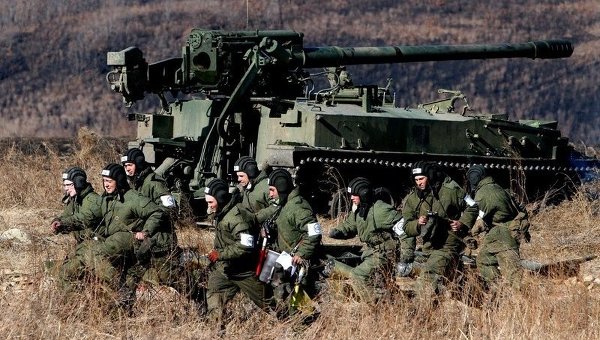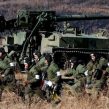
Putin Orders Largest Snap Inspection Exercise of the Year
Publication: Eurasia Daily Monitor Volume: 11 Issue: 162
By:

On September 11, Russian President Vladimir Putin ordered a “snap inspection” of the Armed Forces in Eastern Military District (MD). The motif of the “snap inspection” has been popularized by the defense minister, Army-General Sergei Shoigu, since early 2013 and used to great effect during the Ukraine crisis as an additional tool to maintain Moscow’s pressure on the Ukrainian government and to spread fear among its military and security forces. Despite its focus on the combat readiness and mobility of forces located in the Russian Far East, the exercise has implications for the resolution of the Ukraine crisis and also reveals a number of current priorities for the Russian military (Krasnaya Zvezda, September 11).
First, the specific context of the exercise is important, staged prior to the major operational-strategic exercise of the year: Vostok 2014, also in Eastern MD. During the ongoing combat training year, units in Eastern MD have intensified activities geared at honing skills needed for Vostok 2014. However, the “snap inspection” exercise is also aimed at sending political signals to Kyiv concerning Russian preparedness for a longer strategic commitment to resolving the Ukraine crisis by all means necessary. Additionally, the exercise represents the first actual opportunity for Moscow to respond practically to the decisions taken at the North Atlantic Treaty Organization (NATO) summit in Newport, Wales, on September 4–5 (Nezavisimoye Voyennoye Obozreniye, September 8).
The combined-arms element of the snap inspection involved moving and testing the skills of five combined-arms brigades, while naval infantry and the elite Airborne Forces (VDV) rehearsed coastal assault and various tasks. The snap inspection involved 100,000 military personnel, hardware, aircraft, helicopters, naval vessels and transport aviation in the largest and perhaps most high-profile exercise of its kind this year. Its focus was on refining cross-agency interoperability, improving strategic mobility and strengthening combat service support. Indeed, combat and transport aviation featured heavily in the snap inspection, with assets redeployed from Central and Eastern MDs to airfields in Kamchatka, Khabarovsk and Primorye territories and to Sakhalin. These included MiG-31, Su-24, and An-12 aircraft from Central MD, while IL-76 transport planes relocated troops and equipment in an initial 30 sorties. The Air Force and Air Defense Forces practiced redeploying Su-27s, Su-35s, Su-24s and Mi-8s to alternate airports. During the exercise, elements of the VDV were transported more than 4,000 kilometers to the exercise area to conduct air assault operations on the Kurile Islands. In addition, naval assets were moved into the Sea of Japan and the Sea of Okhotsk (ITAR-TASS, September 12).
The snap inspection was scheduled for September 11–18, and Putin instructed the Ministry of Defense and the “Main Directorate for Special Programs” to jointly check the readiness of several federal ministries, agencies and regional administrations in Eastern MD to perform duties in war-time conditions. These were, the Ministry of Industry and Trade, the Ministry of Communications, the Ministry of Transport, Rospechat (the Federal Press and Mass Communications Agency), Rossvyaz (Federal Telecommunications Agency), Rosaviation (Federal Air Transport Agency), Rosavtodor (Federal Road Agency), Roszheldor (Federal Railway Transport Agency), Rosmorrechflot (Federal Agency for Maritime and River Transport) and organizations subordinate to them, in addition to regional administrations (Interfax, September 12). In addition to rehearsing greater inter-agency cooperation, the exercise appeared to concentrate on improving strategic mobility by involving the entire transportation network with Eastern MD, including land and sea routes (Komsomolskaya Pravda, September 13).
Moreover, Defense Minister Shoigu explained that particular attention was paid to “checking the regrouping of troops over long distances,” noting that the Eastern MD was instructed to create “special task forces” to offer cover for railway and road routes and defend troops in transit. Shoigu demanded that steps be taken “too ensure strict observance of safety measures, the preservation of arms and ammunition, to exclude cases of damage to public property, and prevent negative impacts on the environment.” The defense ministry also informed foreign defense attaches in Moscow embassies about the exercise (Interfax, September 12).
The snap inspection, therefore, appears timed to further boost the performance of units assigned to the operational-strategic exercise Vostok 2014. Defense ministry sources stated that “In the first phase of the test, [officials would be] evaluating the actions of commanders and staffs during the activation of the highest degree of combat readiness,” as well as moving groups of forces. However, the possible scenario or the nature of the threat or threats envisaged during the snap inspection was left vague (Komsomolskaya Pravda, September 13; Interfax, September 12). A defense ministry press release stated: “The purpose of the activities is to check the readiness of units to perform assigned tasks, and the ability of troops to act in crisis situations posing a threat to the military security of the country, including anti-terrorist” (RBK, September 12).
In terms of the scenario, given the assets deployed and the geographical locations involved, it is highly likely that the Russian Armed Forces rehearsed a combined-arms defense of the Russian mainland and the Kurile Islands from hypothetical opponents, no doubt aimed at China and Japan, respectively. The biggest of this year’s Russian military exercises, Vostok 2014 will take place “without the script developed in advance,” according to the chief of the Armed Forces Combat Training, Lieutenant-General Ivan Buvaltsev. Vostok 2014 will also test the latest-generation communications equipment (RIA Novosti, June 19; Siberian Insider, June 9).
The snap inspection in Eastern MD also conveys a message to North Atlantic Alliance after the announcement of its new higher readiness “spearhead” under the NATO Response Force. Moscow is continuing to plug gaps in its strategic mobility, using the snap inspections to practice troop movements over large distances, forming force groupings and refining logistics and combat-service support. Importantly, it appears that Moscow can devise its scenarios more rapidly than the Alliance. The latest snap inspection also reminds the Kyiv government that the threat of escalation of the crisis remains an option for Putin. One recent article in the Russian military press characterized the crisis as being of Ukraine’s making and ended by suggesting that if a winter campaign develops, Moscow may seek to add the overthrow of the Kyiv government to its growing list of conflict resolution demands (Voyenno Promyshlennyy Kuryer, September 17). In the context of its strained relations with NATO, Moscow seems set to use its snap inspections to send clear messages to the Alliance that it is prepared under certain circumstances to challenge it.




